Budapest is a photographer’s dream. The mighty river Danube with its many bridges is a must-see attraction on its own, but there’s so much more to Budapest.
Budapest is not about idyllic town scenery, typical to Central Europe. Nor can you explore the center swiftly on foot, like you could in Prague or Vienna. Instead, Budapest is about fantastic historical attractions scattered in numerous locations. The scenic views, especially by the river Danube and nearby hills, complement the historical sights.

Where to stay in Budapest
Budapest is divided by the Danube into two parts: Pest to the east and Buda to the west of the river. Pest, located on even ground, constitutes the city center, whereas Buda is a hilly area with fewer accommodation options and, for example, limited metro connections.
On the other hand, Castle hill (Buda Castle and Fisherman's Bastion) and Gellert Hill, both of which are popular attractions, are located on the Buda side right next to the river.
In order to reach most of the attractions easily, the best place for staying in Budapest is on the Pest side with flat ground, yet as close to the river as possible. The city center on the Pest side is situated roughly in between the Chain Bridge and the Elizabeth Bridge. This area contains, for example, the pedestrian street, Váci utca, the final stop of the airport bus, Deák Ferenc tér, and the best shopping opportunities.
For a metro map of Budapest, click this link.
Things to do in Budapest
Buda Castle
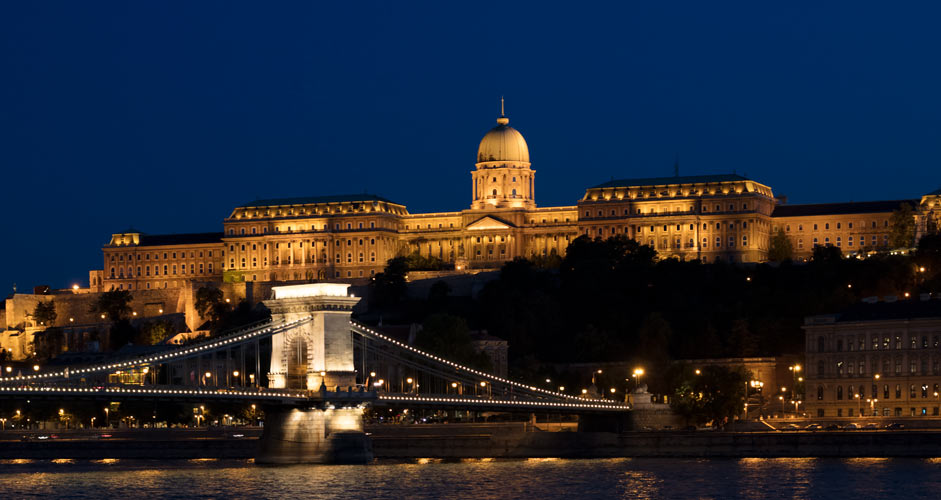
Buda Castle should be at the top of your list of things to see in Budapest. It’s located right next to the city center, across the Chain Bridge, and therefore easy to reach. As a bonus, the castle offers a fantastic view to the river and to Pest.
Most of the castle area can be visited for free. An admission fee is charged only for the main attractions, such as museums.
While visiting the castle, you should consider visiting Fisherman's Bastion as well. It's located only a few hundred meters away from castle.
Both, Buda Castle and Fisherman's Bastion, are situated on Castle Hill (also known as Buda Castle district), and many websites consider them as one attraction.
Buda Castle contains:
- Hungarian National Gallery
- Budapest History Museum
- National Széchényi Library
- Sándor Palace, the official residence of the President of Hungary
- Concerts and festivals
And be sure not to miss the Royal Gardens at the foot of the Castle Hill on the southeastern side.
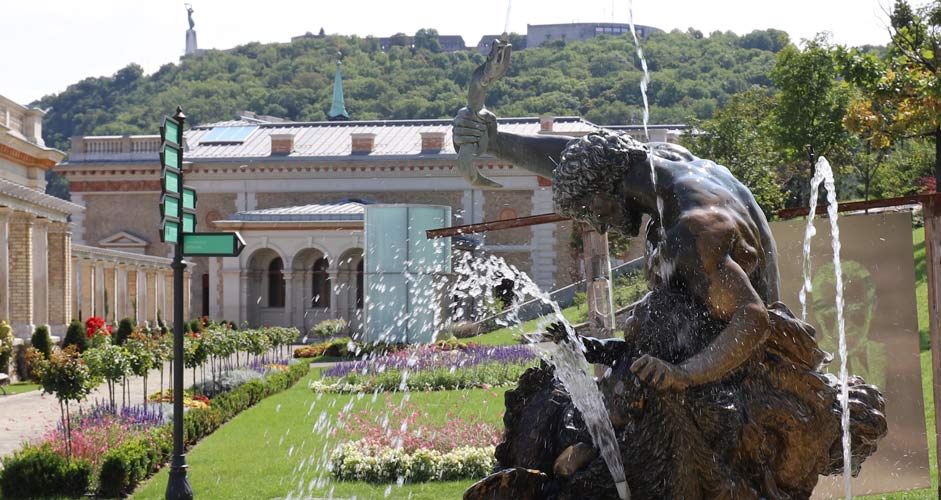
How to get to Buda Castle
- Funicular from Clark Ádám tér (Adam Clarke Square, just after Chain Bridge): It takes you near the Presidential Palace shown in this image. There are long lines to get there in summer, and it costs about 4 euros for adults one way and 6 euros for a round trip. The funicular has been in service since 1870.
- There are mini-trains etc. operating from Clark Ádám tér to the castle. They cost about the same as the funicular.
- The bus lines 16 (from the center of Pest, Deák Ferenc tér to Buda side), 16a (only Buda side), 116 (only Buda side) and 916 (night bus, both sides) should take you to Dísz tér, which is located between the castle and Fisherman's Bastion. Routes and timetables: bkk.hu (choose the light blue bus icon in the middle).
- Walking is the easiest option. You can walk there at least from Clark Ádám tér (take the street Sikló utca), Fisherman's Bastion and Buda side of the castle.
- Also consider this route on foot:
There's a gate to the Royal Gardens halfway between the Elisabeth Bridge and the Chain Bridge. You can walk through that garden and take the escalator upwards. It doesn't take you all the way, but closer nonetheless. There are a couple of elevators in the area, and you can try to find staircases inside the walls to get to the upper levels more quickly. By taking this route, you’ll be able to see a lot more of the castle, especially the Royal Garden, than you would by taking the funicular straight to the top. And it’s free of charge.
Fisherman's Bastion
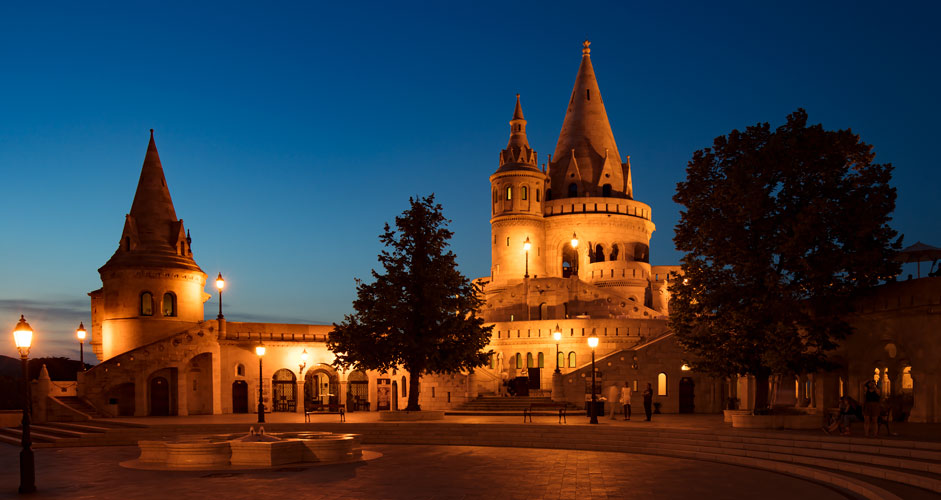
Fisherman's Bastion, Halászbástya, was built between 1895-1902 to celebrate the 1000th birthday of the Hungarian state and the first king of Hungary, Stephen I. Hence, it was never a real fortress but rather a viewing terrace.The area was formerly defended by fishermen, thus the name Fisherman's Bastion.
The area surrounding Fisherman's Bastion is called Castle Hill. Buda Castle is located within a few hundred meters, so it's recommended to visit both attractions at once.
In spite of being far from the center, the whole castle district is a good option for accommodation, since there are good bus connections to the area. In addition, the neighborhood is packed with old architecture and has fantastic views to the river, Margaret Island, the Pest side of the city as well as the hills of Buda. On the downside, the area is very busy near Fisherman's Bastion and Matthias Church.
A map of the area can be found here. The Bastion is found south of the big red dot. The picture covers an area of only about a kilometer, so it's a small district and everything is comfortably visited by foot.
The Castle district also contains:
- Matthias Church, the church seen in many pictures in the gallery above. It's situated right behind Fisherman's Bastion.
- Tower of Mary Magdalene (the remains of the Church of Mary Magdalene), Kapisztrán tér 6
- National Archives of Hungary, Becsi kapu ter 2–4 (450 m northwest of Fisherman's Bastion)
- Underground "Dracula" Labyrinth, Úri utca 9.
- Buda Castle
Museums
- Museum of Military History, Kapisztrán tér 2-4 (in the northwestern corner of the hill; follow the street Tóth Árpád stny and you'll find it)
- Pharmacy Museum, Tárnok utca 18 (almost behind Matthias Church)
- House of Houdini, Museum of Magic and a performance venue, Dísz tér 11 (250 m south of Matthias Church)
- Museum of Music History, 7 Tancsics Mihaly Street (250 m north of Matthias Church)
- Museum of Telephones, Úri utca 49

How to get to Fisherman's Bastion
There are several ways to get to Fisherman's Bastion.
- The Bus lines 16 (from the center of Pest, Deák Ferenc tér to Buda side), 16a (only from Buda side), 116 (only from Buda side) and 916 (night bus, both sides) take you to the bastion, to the bus stop Szentháromság tér. Routes: bkk.hu (choose the light blue bus icon in the middle).
- Funicular from Clark Ádám tér (Adam Clarke Square, just after the Chain Bridge) takes you near the Buda Castle and the Presidential Palace.
- Walk from the previously mentioned Clark Ádám tér. Just follow the street Hunyadi János útca and you’ll get there. It's uphill all the way and about 500-600 meters long. There are stairs (Jezsuita lépcső) at the crossroads of Hunyadi János and Csónak/Donáti utca to provide a shortcut. If you miss those steps, you’ll still see the bastion soon on your left-hand side.
Metro & walk:
- From the Batthyány tér metro station (red line 2): From the metro station, walk across the square and via the left-hand side of the shopping center towards Fisherman's Bastion. There are buildings blocking the view to it, but just continue to the correct direction and you’ll get there even without a map. Make use of the numerous staircases along the way, as they offer a shorter route compared to walking along the roads.
- From the Széll Kálmán tér metro station (red line 2, the next stop after Batthyány tér): From the northeast corner of the square, follow the street Ostrom utca uphill, which will lead you towards Buda castle. At end of the road, there’s an arched vault just about 600 meters away from the Fisherman’s Bastion, also shown on Google maps here. Thereafter, it makes no difference as to which side you’ll pass the church, since both ways will get you to the Bastion.
From Batthyány tér, it's less than a kilometer away on foot, and from the Széll Kálmán tér, a bit more. Both routes are uphill.
Gellert Hill
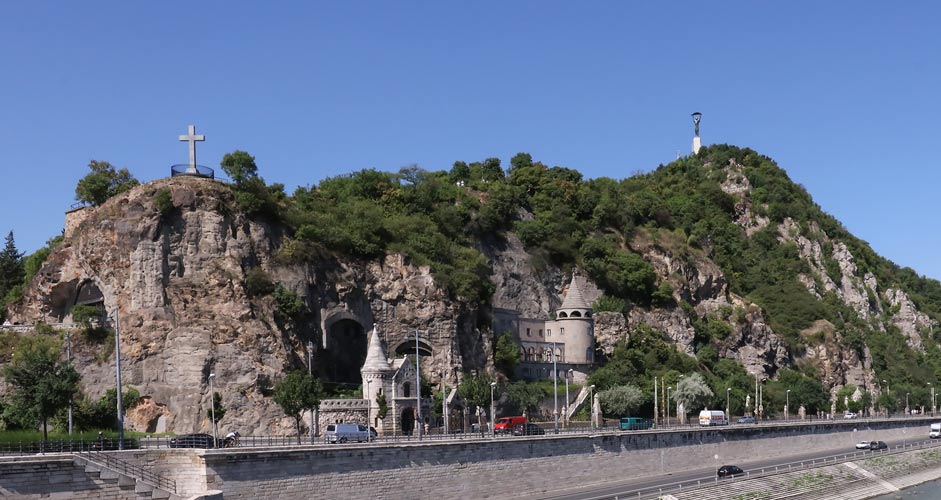
Gellert Hill and the Liberty Statue on top of it are famous landmarks in Budapest. The hill is perfectly located right next to the city center, between Liberty Bridge and Elisabeth Bridge on the Buda side of the city.
Gellert Hill offers the best views over Budapest. There are other attractions as well, such as the Gellért Hill Caves with a church inside. Primarily, however, the hill serves as a great viewing place. It’s also a good place to get away from the buzz of the city for a while.
Things to do in Gellert Hill
Cave Church
Inside the Gellert Hill natural caves, there's a unique church that is worth visiting. It's an active church, and there are daily services during which it is closed for tourists. They charge an admission fee at the entrance. The cave is located by the Liberty Bridge, opposite of the Gellért Spa Hotel. You can see the entrance and the route to walk there in this image.
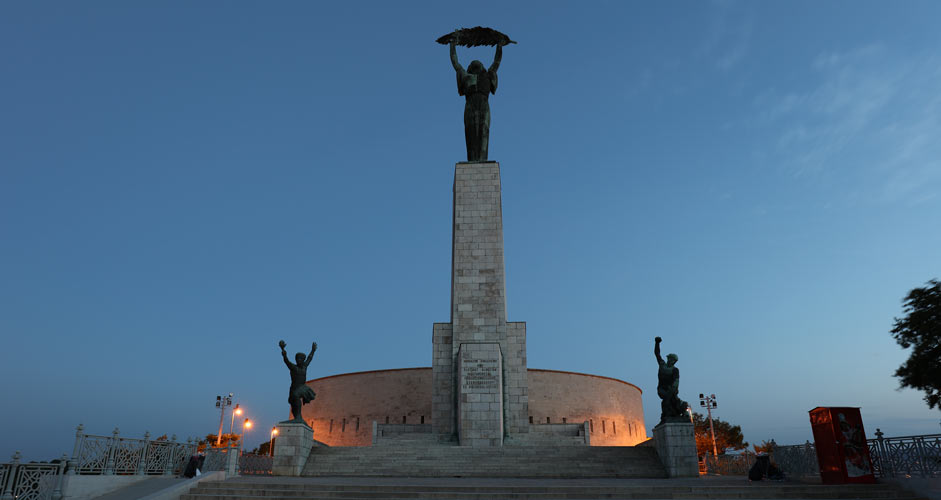
On the top the Gellert Hill, there’s also a citadel from the 19th century, but it’s been closed for visitors for a while now. It's not clear as to when it’ll be reopened again.
The top of the hill is usually packed with tourists in the summertime, especially at sunset. At sunrise, however, there’s hardly anyone there. While the sun sets in the side of the hill, it ascends right across the horizon on the opposite side of Budapest, giving an uninterrupted view - along with some peace and quiet.
How to get to the top of the Gellert Hill
It takes about 15-40 minutes by foot to the top, depending on the route and how fast you want to walk. There are plenty of walking routes starting from either flank or the Buda side, but none from the side facing the river.
The best option is probably on the side of Gellért Hotel/Spa (left-hand side from the river). There are plenty of staircases offering a quick way straight to the top, but bear in mind that they’re also the most exhausting ones on a hot day.
Some stairs are steeper and some gentler. There are some resting/viewing points on the way, and the view is great.
The routes starting from the Buda Castle side (right-hand side from the river) are easier to walk. On a sunny day, there’s more shade from the trees as well. Obviously, however, it's a longer walk than via the stairs on the other side.
Many Hop-on hop-off buses stop very close to the Citadel on the top, just a few-minute walk from the parking lot. That's a good option, if you are going to take a sight-seeing tour anyway and don't want to walk the whole way to the top.
The bus line 27 goes pretty near to the top but not all the way, and there’s still about 500 meters of walking to do on a normal sidewalk. The nearest bus stop to the top is called Búsuló Juhász (Citadella).
That line isn't very convenient to most tourists, since it runs only on the Buda side. Another alternative is to take a metro to the Móricz Zsigmond körtér station (metro line 4) and take the bus 27 from there.
City Park
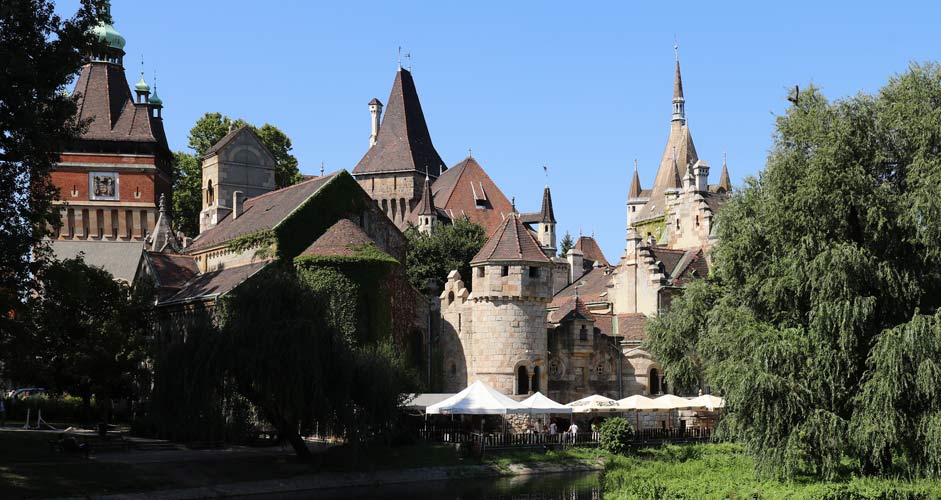
Budapest City Park (Hun. Városliget) holds several attractions and activities within a small area. Moreover, there are wide grass areas to enjoy on the southern side of the park.
Heroes’ Square (Hun. Hősök tere) is one of the landmarks in Budapest and located right next to the park. Therefore, Heroes’ Square is a must on your itinerary, if you decide to visit Budapest City Park.
Attractions in City Park
At Heroes' Square:
- Millennium Monument, which was erected in 1896 to celebrate the 1000th birthday of the Hungarian state
- Museum of Fine Arts (link)
- Art Hall (link)
At the Park:
- Széchenyi Baths (more information below)
- Vajdahunyad Castle (more information below)
- The Museum and Library of Hungarian Agriculture – At the castle
- Chapel of Ják - A small chapel at the courtyard of the castle
- Zoo and Botanical Garden (link)
- Capital Circus of Budapest (link)
- Museum of Transportation - At the northeast corner of the park (link)
- Skating rink in the winter and boating lake in the summer
- Restaurants and cafes
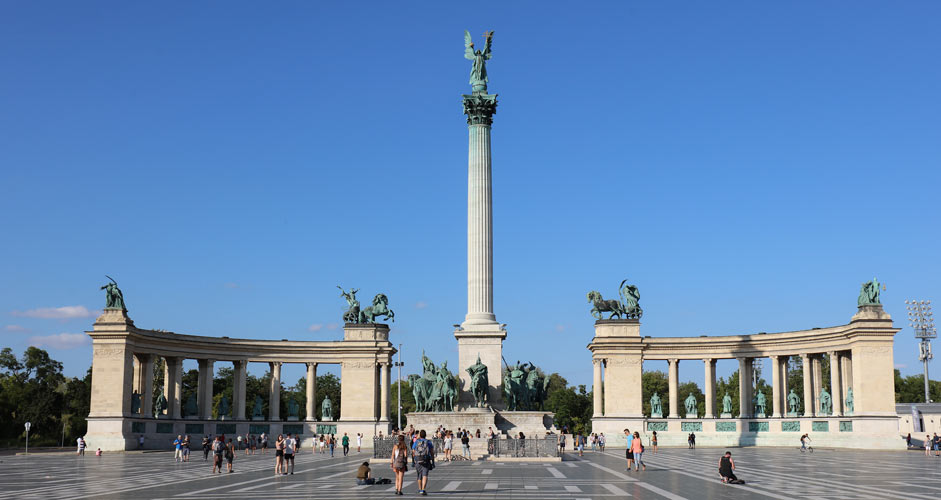
Széchenyi Baths
Széchenyi Baths, the biggest and the most famous spa in Budapest, is situated in City Park. The spa has both, indoor and outdoor pools. The indoor pools are rather simple, with a variety of temperatures. Outside, there are different types of pools; a normal large pool with whirls, a longer pool for swimming, and a 38℃ pool. Different kinds of massages are available as well.
There’s a cafe/snack bar inside that is open all year. In the summertime, there’s also a terrace outside and sunbeds all over the area.
There are no slides or other amusements in Széchenyi Baths, so it’s more suitable for adults than for young children.
Some basic information for the first-time visitors:
- It’s better to book tickets in advance, to avoid having to wait in line.
- When booking the tickets, it’s possible to reserve a private changing room for an additional cost.
- There’re dozens of parties each year in Széchenyi Baths. Be sure to check the dates in advance on their website - either to join or avoid the parties.
- Swimming shorts are allowed. A swimming cap is not needed unless you’re going to swim in the long pool.
- It’s best to bring your own towel along; there are places for keeping the towels at least by the showers. It’s also possible to rent or buy one at the baths. Slippers and bathrobe are also good to bring along, especially in the winter.
- A wallet is needed at the cafe/terrace.
- Photographing is allowed.
Tickets and more information: szechenyispabaths.com
Vajdahunyad Castle
Vajdahunyad Castle was originally built for the Millennial Exhibition in 1896, to celebrate the 1000th birthday of the Hungarian state. The Millennium Monument at the Heroes’ Square, and the Fisherman’s Bastion at the Buda side of the river, were also built in celebration of the Hungarian Millennium. Vajdahunyad never was a real castle, though. It was only a temporary establishment, built from light materials for the exhibition. Nonetheless, the inhabitants of Budapest were excited about the castle, and it was rebuilt on the same location a few years later. This time it was built with better materials and it’s still standing there today, on the same exact location.
The different parts of the castle are all replicas of buildings around Hungary. For example, a bigger version of the Chapel of Ják can be found at the village of Ják, on the Hungarian and Austrian border.
Today, the main castle houses the Museum of Hungarian Agriculture. You can walk around the castle courtyard for free, but an admission fee is collected for the museum and chapel.
More information: vajdahunyadcastle.com
How to get to City Park
Underground: The yellow line number 1 begins at Vörösmarty Square in the city center. The route goes along the wide Andrássy Avenue towards the park, and you can enter at any of the several stations along the way. If you want to exit at Heroes' Square, the correct stop is Hősök tere. Or if, for instance, you are planning to go to the Széchenyi Baths, the stop Széchenyi fürdő is right in the middle of the park and by the baths.
You may find the stations and cars of the line old-fashioned. That’s because the Budapest metro is the second-oldest electrically operated underground railway in the world (first was London), and it’s been in continuous operation ever since 1896. The line was listed as a UNESCO World heritage site in 2002.
Getting to the park by foot via the Andrássy Avenue (Andrássy ut) isn't a bad idea either. The avenue is about three kilometers long, begins with high-end shops and restaurants, and ends with embassies and other beautiful buildings.
Margaret Island
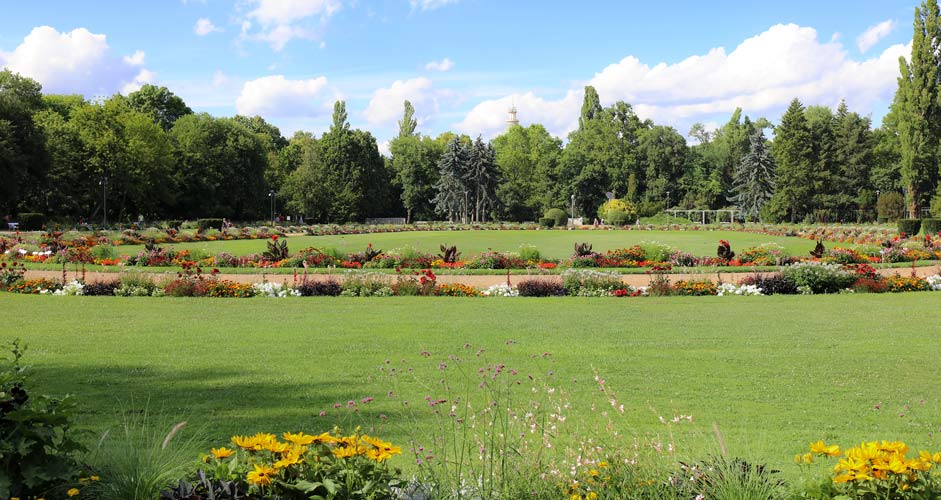
Margaret Island is situated in the middle of the River Danube, north of Budapest. The large island is within walking distance from the city center via Margaret Bridge, but there are several options for public transport as well.
From a distance, Margaret island seems as though it’s mainly covered with forest, but the amount of attractions on the island is just amazing. And yet, there are plenty of wide grass areas around, perfect for a picnic.
Few-hour day trips are the most usual way to visit Margaret Island. However, the island may also serve as a good option for a longer stay, since there are a couple of hotels as well. The distance between the hotels and the Deák Ferenc Square in the city center is five kilometers.
Attractions on Margaret Island:
- Two hotels Danubius Health Spa Resort and Danubius Grand Hotel and Island Hostel (links to booking.com)
- Restaurants, bars and cafes
- Athletics stadium
- Alfred Hajos Swimming stadium
- Palatinus Open-air baths (web page)
- Water tower with a viewing place at the top (in the summertime most of what you'll see are tree tops) and a restaurant at the ground level.
- Open-air theater
- Musical fountain
- Rose garden
- Japanese garden
- Small Pet Zoo - more information: zoobudapest.com
- Medieval ruins
- Almost non-stop running track around the island
While it’s comfortable to walk on the island, you’re in for a long haul to see everything by foot. Even the straight-line distance across the island is 2,5 kilometers. There are several places to rent a vehicle though, a multi person bicycle being a popular choice.
Musical Fountain on Margaret Island
In the summertime, one of the main attractions on Margaret Island is the musical fountain. While it’s a typical fountain most of the time, it turns into a show with music and lights (in the dark) a few times a day.
The music types vary from classical to rock music; Swan Lake by Tchaikovsky can suddenly change to Sweet Child o' Mine by Guns n' Roses, and the shapes and lights of the fountain adjust accordingly.
There are a lot of videos on YouTube, if you wish to take a closer look.
There are some shows in the daytime, but the main show should start at 21.00. It's already dark then, but with the light show it's more impressive than during the day.
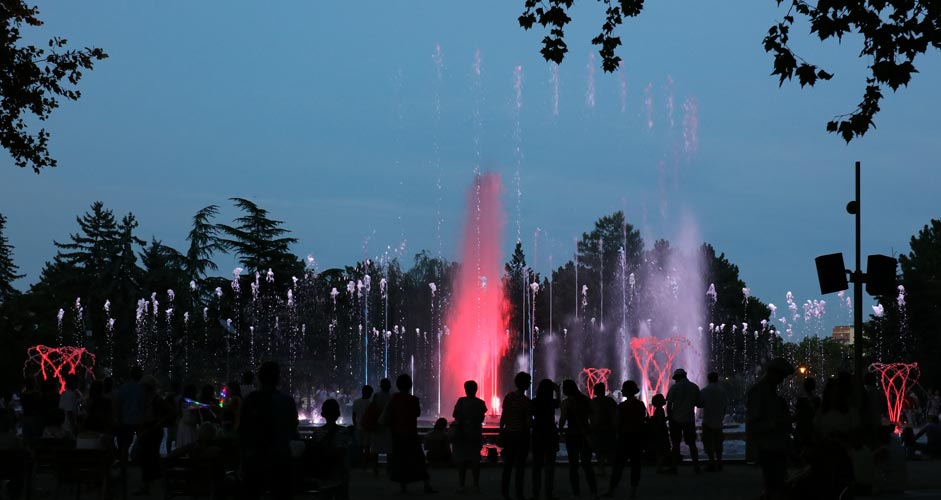
How to get to Margaret Island:
- There’s a bus route through the island, and you can exit at several stops.
- A Tram takes you to the Margaret Bridge, just in front of the island.
- The nearest metro stop is at Nyugati train station. The distance from there to the island is one kilometer.
- If you accommodate by the river, a ferryboat is also an option. There's a stop on the eastern side of the island, close to the Margaret Bridge. The stop is called Margitsziget, Centenáriumi emlékmű.
Timetables for all options: bkk.hu. Just click on the icon of your choice for different kinds of transportation.
Hungarian Parliament Building
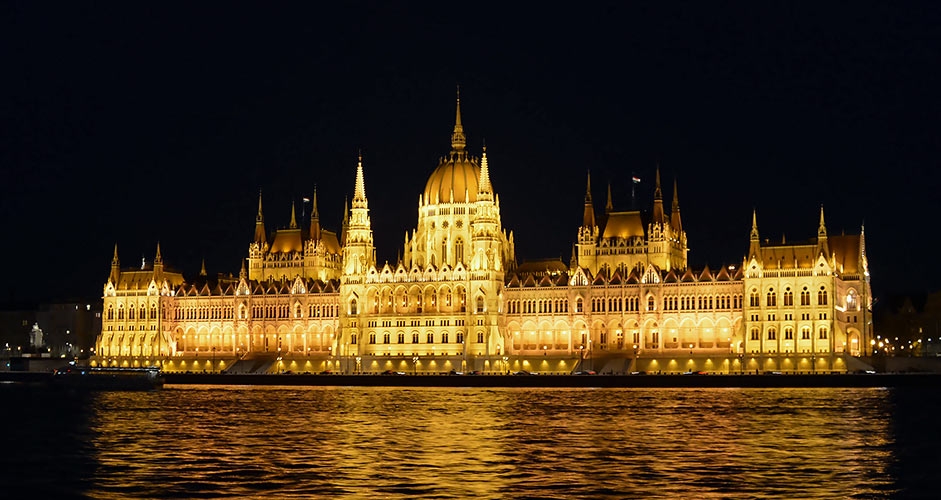
Visit the Parliament building from outside or participate in a guided tour inside. For more information on tickets, check: jegymester.hu
River Cruises
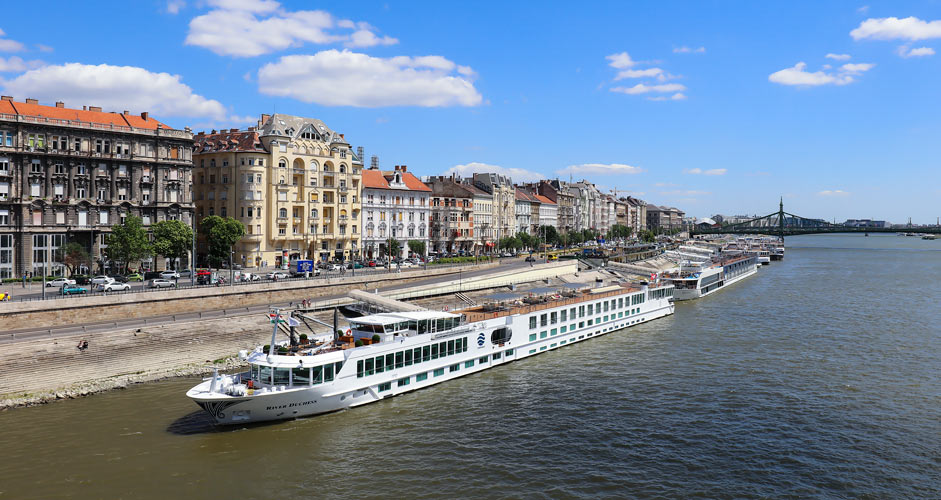
There’re plenty of options for river cruises on the Danube. They range from one-to-two-hour cruises to longer ones with candle light dinner at sunset. Or, while you’re at it, head off to Amsterdam and spend a week or two.
It’s recommended to book tickets online in advance, even for short cruises.
Most boats are situated at the piers on the Pest side of the river, right in the center. In fact, the central river bank is packed with boats. Follow the pier numbers, and you’ll be able to find the correct boat with ease.
Váci street
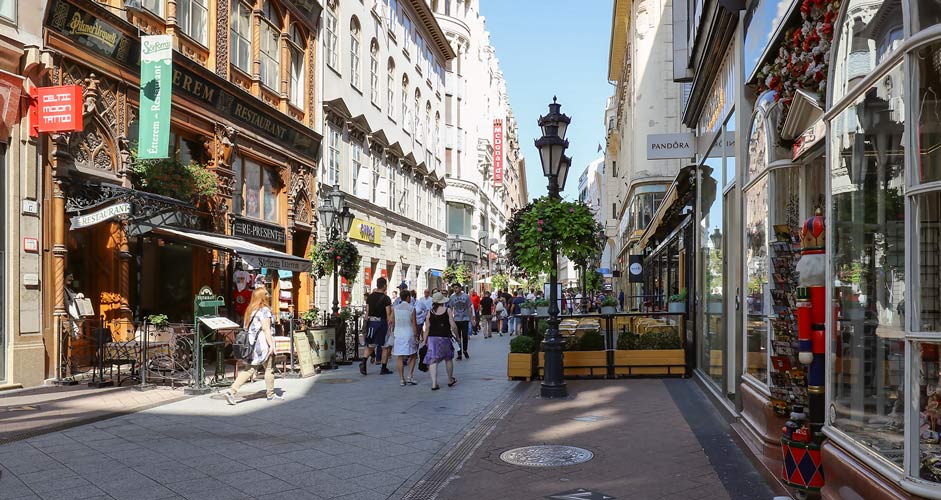
Váci utca is a long pedestrian street parallel to the river on the Pest side of the city.
The street is packed with shops and restaurant terraces, mostly aimed at tourists. Therefore, the price-quality ratio may not be optimal. Nonetheless, it’s a nice street to stroll around.
Bridges in Budapest
While there are a few more bridges in the Budapest area, the four most decorative and centrally located ones are introduced in this article.
The order of presenting the bridges is from north to south in terms of their location.
The bridges are great places on a hot day, since there's always a cool breeze from the river to cool you off. And the scenery couldn't be better.
Margaret Bridge (Margit híd)
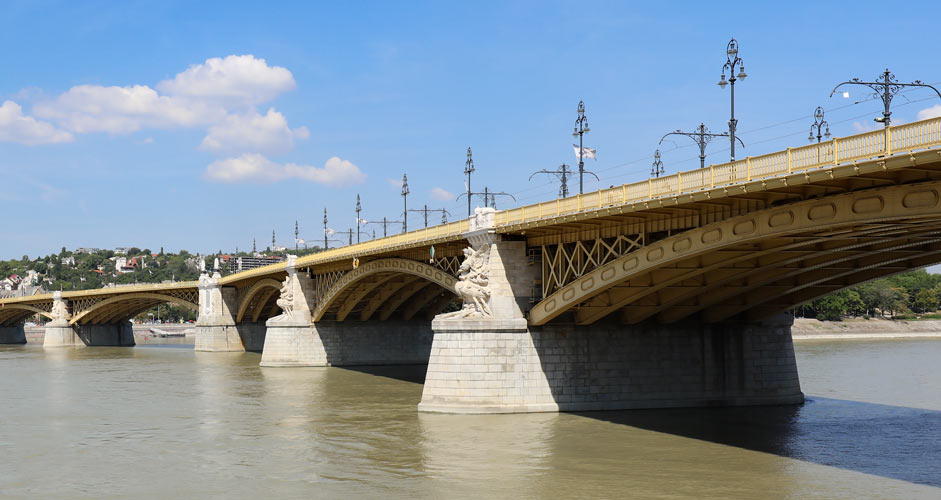
Margaret Bridge is located a little outside the Budapest city center. It's the second oldest permanent bridge in Budapest and the easiest way to get to Margaret Island.The bridge is not straight, as it makes a turn at the crossroads to Margaret Island. The extension to the island wasn't built simultaneously with the original bridge. Before building the extension, the only way to get to Margaret Island was by boat.
There are separate lanes for cars, trams, bicycles and pedestrians on Margaret Bridge.
- The closest metro station on the Pest side: Nyugati Pályaudvar (700 m)
- The closest metro station on the Buda side: Batthyány tér (900 m)
Chain Bridge (Széchenyi Lánchíd)
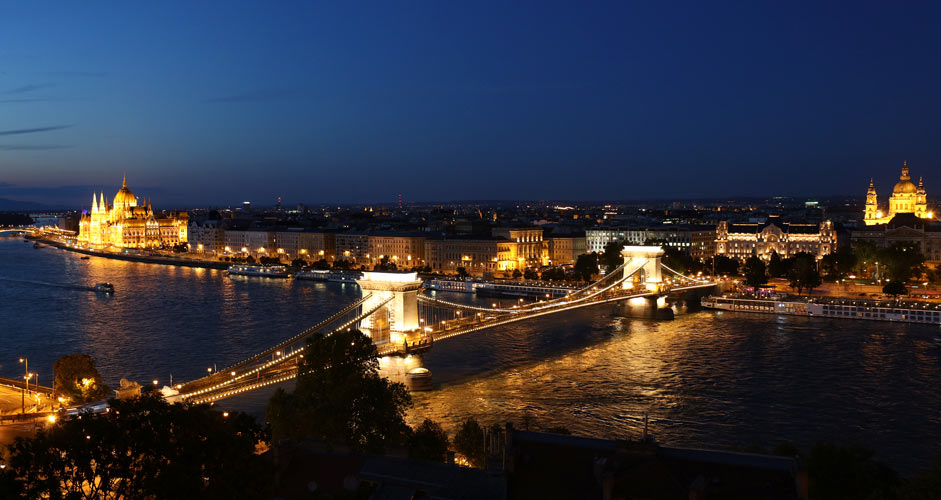
Chain Bridge is the oldest and the most famous permanent bridge in Hungary. It is known especially for the four stone lions, all situated in their own respective corners of the bridge.There are sidewalks for the pedestrians.
- The closest metro station on the Pest side: Vörösmarty tér (550 m)
- The closest metro station on the Buda side: Batthyány tér (1000 m)
Elisabeth Bridge (Erzsébet híd)
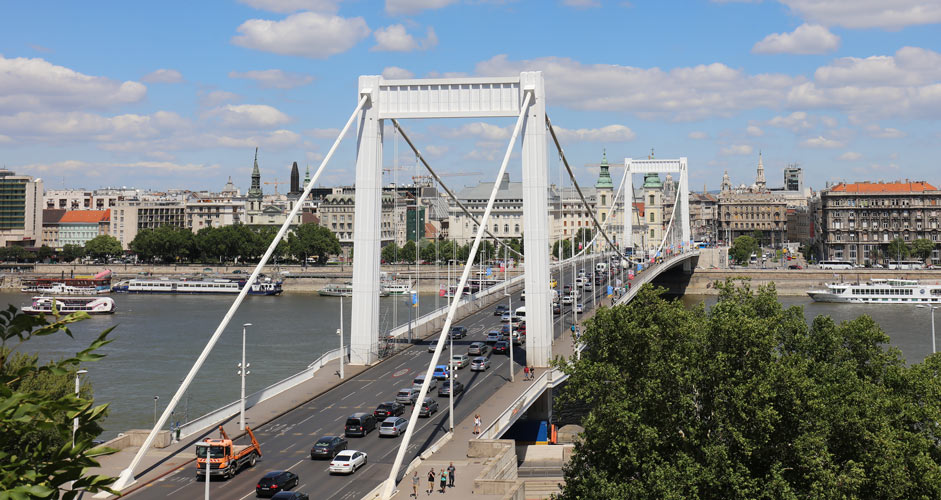
Elisabeth Bridge was built relatively recently. It was originally built between 1897-1903 but blown up at the end of World War II just like the rest of these bridges. Elisabeth Bridge was the only one that wasn't rebuilt. Instead, it was replaced by a new cable bridge, now standing on the original foundations.As is the case with the other bridges, there are sidewalks for the pedestrians.
- The closest metro station on the Pest side: Ferenciek tere (400 m)
- The closest metro station on the Buda side: Szent Gellért tér (1000 m)
Liberty Bridge (Szabadság híd)
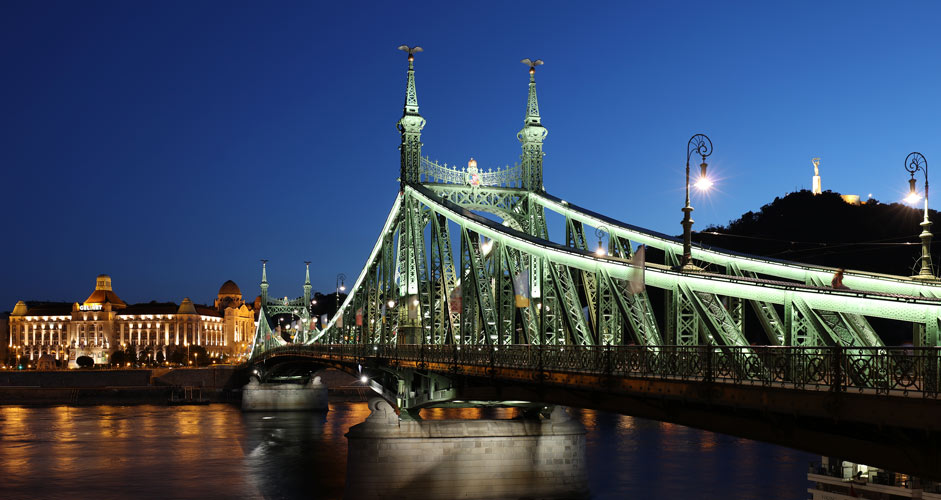
Liberty Bridge is the shortest of the four bridges. The four birds on top of the bridge depict the mythological Turul birds. You can find the statue of the same bird flying in front of the Buda Castle.On the Pest side, south of Liberty Bridge, there's a nice promenade to have a drink or eat very close to the river.
There are lanes for cars and trams as well as sidewalks for the pedestrians.
- The closest metro station on the Pest side: Fővám tér (50 m)
- The closest metro station on the Buda side: Szent Gellért tér (150 m)
Shopping in Budapest
The best shopping streets are situated near the squares Vörösmarty tér and Deák Ferenc tér. The pedestrian street Váci utca unfolds southwards from Vörösmarty tér. The northern end of the street contains more clothing stores than the southern end.
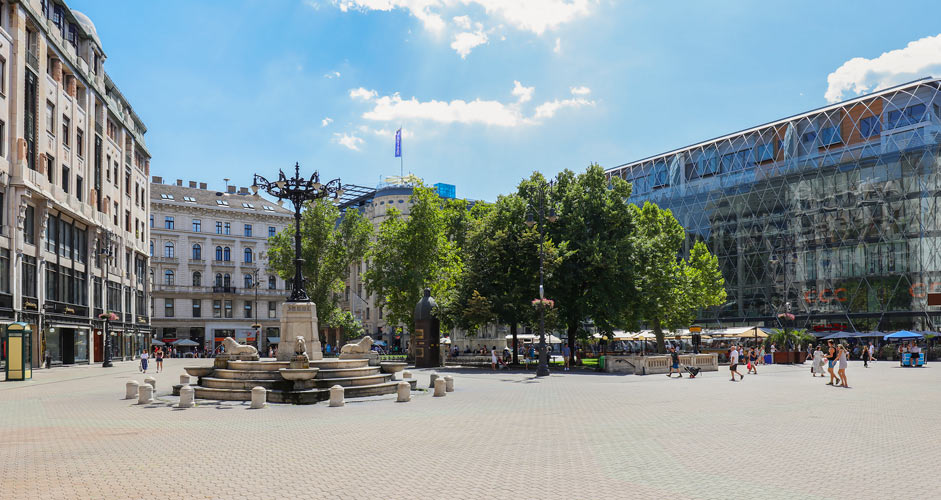
Also starting from Vörösmarty tér, Deák Ferenc utca unfolds towards Deák Ferenc tér. Deák Ferenc utca is known as the Fashion Street of Budapest.
Luxury brands such as Gucci and Luis Vuitton have stores at the beginning of Andrássy Út, north of Deák Ferenc tér. Andrássy Út is referred to as Champs-Élysées of Budapest.
There’s a tendency from smaller shops to large shopping centers, which are in abundance near the center of Budapest. Some of the largest shopping centers are listed below:
- Arena (Plaza) – Near the main railway station, Keleti, 700 meters away on foot. The metro stop is called Keleti pályaudvar (green and red line). Website: arenamall.hu
- WestEnd City Center – Next to the western railway station Nyugati. The blue line metro stop is called Nyugati pályaudvar (blue line). Website: westend.hu
- Allee – Southside of Buda. The closest metro stops are called Móricz Zsigmond körtér or Újbuda-központ (green line). Website: allee.hu
- Mammut – North of Castle Hill. The metro stop is called Széll Kálmán tér (red line). Website: mammut.hu
Home chefs will surely appreciate shopping centers, as they contain well-equipped grocery stores, which are otherwise hard to find in central Budapest. At least Arena and Allee have fine grocery stores (Tesco and Interspar) on the bottom floor. Obviously, Budapest also contains a large market hall, which is situated at the southern end of Váci street.
Porcelain items, especially by Herend, are common presents to bring back home.
Prices
Regardless of products, prices are low compared to Central Europe. Below, there are examples of restaurant and hotel prices in Budapest. The hotel prices refer to median prices in Budapest city center at Booking.com.
Pizza in restaurant
33 cl beer in restaurant
Hotel, 3-4 stars (April)
Hotel, 3-4 stars (July)
€9-12
€3-4
€96
€98
From the airport to the center
- There’s an airport bus 100E operating between the airport and the center. You’re required to buy a certain ticket (900 HUF, less than 3 euros). Other public transport tickets or passes are not accepted.
There are three bus stops in the center, all close to each other: Kalvin tér, Astoria and Deák Ferenc tér. When returning to the airport, Deák Ferenc tér and Kalvin tér along the way, are in use all the time. Astoria is available only in very early mornings.
For more information, check here. - A taxi is a good choice in Budapest:
A taxi company called Fö has an exclusive right with the airport to have taxis waiting at the main entrance of the airport.
First, give the details of your taxi travel at a booth at the main entrance: the destination, number of passengers and the number of luggage. You’ll receive a document with an estimate of the price and the code of the taxi. This document is given to a taxi driver, who’ll soon drive next to the booth. Passengers are instructed to the correct taxi, and there’s usually no need to look for it. The final price is determined by the meter. The fee, which is very close to the estimate, is paid to the driver.
Weather in Budapest
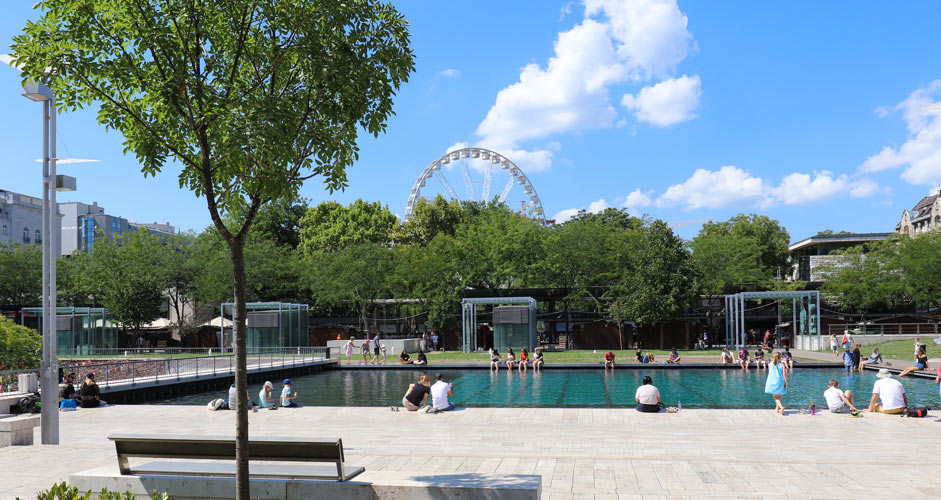 Winter: In winter, the weather fluctuates from snowy frost to sunny with temperatures well above zero. In general, there’s no permanent snow.
Winter: In winter, the weather fluctuates from snowy frost to sunny with temperatures well above zero. In general, there’s no permanent snow.
Spring: In March, sub-zero temperatures are possible, but daily highs swing back and forth around 10°C. In April, the weather fluctuates from 10°C to summery warm. Trees grow leaves during the first half of April. In May, daytime weather resembles summer time, but nights are cool.
Summer: It’s hot and dry in summer. Temperatures are close to 30°C and above, especially in July and August. It rains rarely, but when it does, a thunderstorm is likely.
Fall: September is cooler but still summery, and thus a good time for a visit. October is a turning point towards winter weather. In November, first subzero nights may appear. The weather gets grayer and grayer the further the fall progresses.
---
Text and images: Jussi Ryynänen